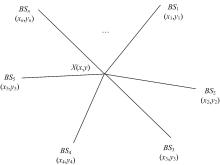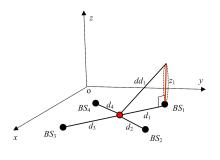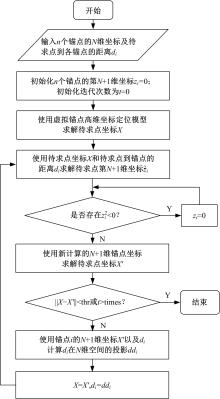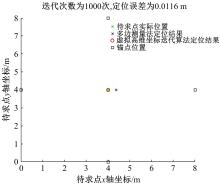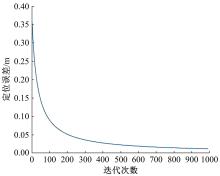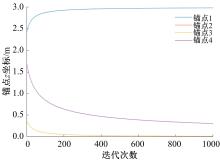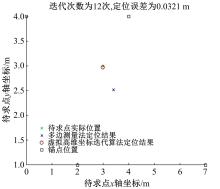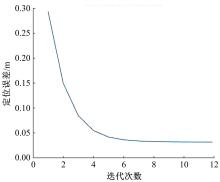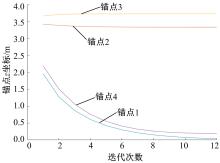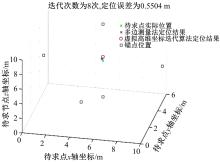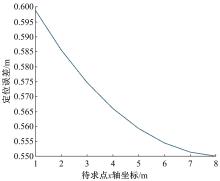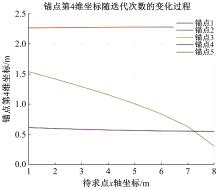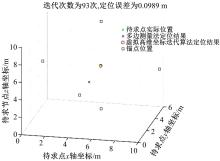Journal of Jilin University(Engineering and Technology Edition) ›› 2021, Vol. 51 ›› Issue (6): 2207-2215.doi: 10.13229/j.cnki.jdxbgxb20210590
Non⁃line⁃of⁃sight identification and optimization based on virtual coordinates of anchors
Da-yang SUN1( ),Xue-ying WANG1,Shuang-xue HAN1,Hui ZHONG2(
),Xue-ying WANG1,Shuang-xue HAN1,Hui ZHONG2( ),Jiang-nan DAI3
),Jiang-nan DAI3
- 1.College of Communication Engineering,Jilin University,Changchun 130012,China
2.Management Center of Big Data and Network,Jilin University,Changchun 130012,China
3.College of Software,Jilin University,Changchun 130012,China
CLC Number:
- TP39
| 1 | 孙大洋,章荣炜,李赞. 室内定位技术综述[J].无人系统技术, 2020, 3(3): 32-46. |
| Sun Da-yang, Zhang Rong-wei, Li Zan. Survey of indoor localization[J]. Unmanned Systems Technology, 2020, 3(3): 32-46. | |
| 2 | Zhao S H, Zhang X P, Cui X W, et al. A new toa localization and synchronization system with virtually synchronized periodic asymmetric ranging network[J]. IEEE Internet of Things Journal, 2021, 8(11): 9030-9044. |
| 3 | Deng Z L, Zheng X Y, Zhang C Y, et al. A tdoa and pdr fusion method for 5g indoor localization based on virtual base stations in unknown areas[J]. IEEE Access, 2020, 8:225123-225133. |
| 4 | Ma Y T, Wang B B, Pei S Y, et al. An indoor localization method based on AOA and PDOA using virtual stations in multipath and NLOS environments for passive UHF RFID[J]. IEEE Access, 2018, 6: 31772-31782. |
| 5 | 刘富, 权美静, 王柯, 等. 仿蝎子振源定位机理的位置指纹室内定位方法[J]. 吉林大学学报: 工学版, 2019, 49(6): 2076-2082. |
| Liu Fu, Quan Mei-jing, Wang Ke, et al. Indoor positioning method based on location fingerprinting of imitating mechanism of scorpion vibration source[J]. Journal of Jilin University(Engineering and Technology Edition), 2019, 49(6): 2076-2082. | |
| 6 | Cheng L, Wu H, Wu C D, et al. Indoor mobile localization in wireless sensor network under unknown NLOS errors[J]. International Journal of Distributed Sensor Networks, 2013,9(2): 4338-4348. |
| 7 | Momtaz A A, Behnia F, Amiri R, et al. NLOS identification in range-based source localization: Statistical approach[J]. IEEE Sensors Journal, 2018, 18(9): 3745-3751. |
| 8 | Yang X F. NLOS mitigation for UWB localization based on sparse pseudo input Gaussian process[J]. IEEE Sensors Journal, 2018, 18(10): 4311-4316. |
| 9 | Ma Y T, Wang B B, Pei S Y, et al. An indoor localization method based on AOA and PDOA using virtual stations in multipath and NLOS environments for passive UHF RFID[J]. IEEE Access, 2018, 6: 31772-31782. |
| 10 | Shrivastava A, Bharti P. Localization techniques in wireless sensor networks[J]. International Journal of Computer Applications, 2015,116(12):13-18. |
| 11 | Choi J S, Lee W H, Lee J H, et al. Deep learning based NLOS identification with commodity WLAN devices[J]. IEEE Transactions on Vehicular Technology, 2018, 67(4): 3295-3303. |
| 12 | Ramadan M, Sark V, Gutierrez J,et al. NLOS identification for indoor localization using random forest algorithm[C]∥In Proc 22nd Int ITG Workshop Smart Antennas, Bochum, Germany, 2018:1-5. |
| 13 | 肖竹, 宋宝相, 孙宛, 等. 基于UWB定位误差统计特性分析的NLOS鉴别[J]. 吉林大学学报: 工学版, 2010, 40(5): 1381-1385. |
| Xiao Zhu, Song Bao-Xiang, Sun Wan, et al. NLOS identification based on statistic analysis of UWB localization error[J]. Journal of Jilin University(Engineering and Technology Edition), 2010, 40(5): 1381-1385. | |
| 14 | Jiang C H, Shen J C, Chen S, et al. UWB NLOS/LOS classification using deep learning method[J]. IEEE Communications Letters, 2020, 24(10): 2226-2230. |
| 15 | Zhu Y H, Ma T F, Li Z J, et al. NLOS identification and correction based on multidimensional scaling and quasi-accurate detection[J]. IEEE Access, 2019, 7: 53977-53987. |
| 16 | Mass-Sanchez J, Vargas-Rosales C, Ruiz-Ibarra E, et al. Localization based on probabilistic multilateration approach for mobile wireless sensor networks[J]. IEEE Access, 2020, 8: 54994-55011. |
| [1] | Jin-peng WANG,Zheng-peng YE,Fan CAO,Nian-yu ZOU. Cooperative distributed antenna transmission method based on co-channel interference in 5G mobile communication system [J]. Journal of Jilin University(Engineering and Technology Edition), 2020, 50(1): 333-341. |
| [2] | Cui-ran LI,Yong-sheng YU,Jian-li XIE. Dynamic game algorithm for spectrum sharing based on priority of secondary users [J]. Journal of Jilin University(Engineering and Technology Edition), 2020, 50(1): 315-323. |
| [3] | Yi LIU,Ling-ling XIAO,Gai-jing WANG,Wu-jun ZHANG. Resource allocation algorithm based joint optimization for D2D communications in cellular networks [J]. Journal of Jilin University(Engineering and Technology Edition), 2020, 50(1): 306-314. |
| [4] | Fu LIU, Mei-jing QUAN, Ke WANG, Yun LIU, Bing KANG, Zhi-wu HAN, Tao HOU. Indoor positioning method based on location fingerprinting of imitating mechanism of scorpion vibration source [J]. Journal of Jilin University(Engineering and Technology Edition), 2019, 49(6): 2076-2082. |
| [5] | Wen-jun LI,Qiang HUA,Li-dong TAN,Yue SUN. An improved algorithm for combination of DV-HOP and RSSI [J]. Journal of Jilin University(Engineering and Technology Edition), 2019, 49(5): 1689-1695. |
| [6] | Hong-yan WANG,Yun-fei FANG,Sheng-qi ZHU,Bing-nan PEI. DOA estimation method considering mutual coupling effect in presence of non⁃uniform noise [J]. Journal of Jilin University(Engineering and Technology Edition), 2019, 49(5): 1706-1714. |
| [7] | Yong LIU,Fang⁃shun DENG,Xiao⁃lin LIU,Si⁃jie MIN,Peng WANG. Frequency estimation of minimum shift keying signal based on dual chaotic oscillator [J]. Journal of Jilin University(Engineering and Technology Edition), 2019, 49(4): 1357-1362. |
| [8] | Hong⁃zhi WANG,Fang⁃da JIANG,Ming⁃yue ZHOU. Power allocation of cognitive radio system based on genetic particle swarm optimization [J]. Journal of Jilin University(Engineering and Technology Edition), 2019, 49(4): 1363-1368. |
| [9] | ZHOU Yan-guo,ZHANG Hai-lin,CHEN Rui-rui,ZHOU Tao. Two-level game approach based resource allocation scheme in cooperative networks [J]. Journal of Jilin University(Engineering and Technology Edition), 2018, 48(6): 1879-1886. |
| [10] | SUN Xiao-ying, HU Ze-zheng, YANG Jin-peng. Assessment method of electromagnetic pulse sensitivity of vehicle engine system based on hierarchical Bayesian networks [J]. 吉林大学学报(工学版), 2018, 48(4): 1254-1264. |
| [11] | DONG Ying, CUI Meng-yao, WU Hao, WANG Yu-hou. Clustering wireless rechargeable sensor networks charging schedule based on energy prediction [J]. 吉林大学学报(工学版), 2018, 48(4): 1265-1273. |
| [12] | DING Ning, CHANG Yu-chun, ZHAO Jian-bo, WANG Chao, YANG Xiao-tian. High-speed CMOS image sensor data acquisition system based on USB 3.0 [J]. 吉林大学学报(工学版), 2018, 48(4): 1298-1304. |
| [13] | MOU Zong-lei, SONG Ping, ZHAI Ya-yu, CHEN Xiao-xiao. High accuracy measurement method for synchronous triggering pulse transmission delay in distributed test system [J]. 吉林大学学报(工学版), 2018, 48(4): 1274-1281. |
| [14] | CHEN Rui-rui, ZHANG Hai-lin. Performance analysis of 3D millimeter wave communications [J]. 吉林大学学报(工学版), 2018, 48(2): 605-609. |
| [15] | GUAN Ji-shi, SHI Yao-wu, QIU Jian-wen, SHAN Ze-biao, SHI Hong-wei. New algorithm to estimate characteristic exponent of α-stable distribution [J]. 吉林大学学报(工学版), 2018, 48(2): 618-624. |
|
||
